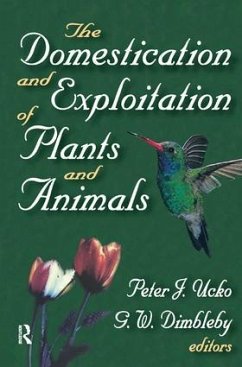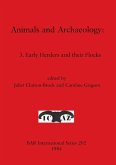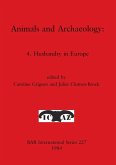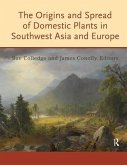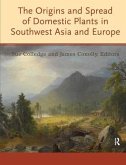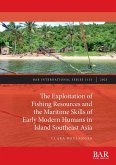G. W. Dimbleby
The Domestication and Exploitation of Plants and Animals
G. W. Dimbleby
The Domestication and Exploitation of Plants and Animals
- Gebundenes Buch
- Merkliste
- Auf die Merkliste
- Bewerten Bewerten
- Teilen
- Produkt teilen
- Produkterinnerung
- Produkterinnerung
The domestication of plants and animals was one of the greatest steps forward taken by mankind
Andere Kunden interessierten sich auch für
![Domestic Animals and Stability in Pre-State Farming Societies Domestic Animals and Stability in Pre-State Farming Societies]() Carol RaishDomestic Animals and Stability in Pre-State Farming Societies58,99 €
Carol RaishDomestic Animals and Stability in Pre-State Farming Societies58,99 €![Animals and Archaeology Animals and Archaeology]() Animals and Archaeology203,99 €
Animals and Archaeology203,99 €![Animals and Archaeology Animals and Archaeology]() Animals and Archaeology142,99 €
Animals and Archaeology142,99 €![The Challenges of Working with Child Sexual Exploitation and How a Psychoanalytic Understanding Can Help The Challenges of Working with Child Sexual Exploitation and How a Psychoanalytic Understanding Can Help]() The Challenges of Working with Child Sexual Exploitation and How a Psychoanalytic Understanding Can Help200,99 €
The Challenges of Working with Child Sexual Exploitation and How a Psychoanalytic Understanding Can Help200,99 €![The Origins and Spread of Domestic Plants in Southwest Asia and Europe The Origins and Spread of Domestic Plants in Southwest Asia and Europe]() The Origins and Spread of Domestic Plants in Southwest Asia and Europe57,99 €
The Origins and Spread of Domestic Plants in Southwest Asia and Europe57,99 €![The Origins and Spread of Domestic Plants in Southwest Asia and Europe The Origins and Spread of Domestic Plants in Southwest Asia and Europe]() The Origins and Spread of Domestic Plants in Southwest Asia and Europe211,99 €
The Origins and Spread of Domestic Plants in Southwest Asia and Europe211,99 €![The Exploitation of Fishing Resources and the Maritime Skills of Early Modern Humans in Island Southeast Asia The Exploitation of Fishing Resources and the Maritime Skills of Early Modern Humans in Island Southeast Asia]() Clara BoulangerThe Exploitation of Fishing Resources and the Maritime Skills of Early Modern Humans in Island Southeast Asia83,99 €
Clara BoulangerThe Exploitation of Fishing Resources and the Maritime Skills of Early Modern Humans in Island Southeast Asia83,99 €-
-
-
The domestication of plants and animals was one of the greatest steps forward taken by mankind
Hinweis: Dieser Artikel kann nur an eine deutsche Lieferadresse ausgeliefert werden.
Hinweis: Dieser Artikel kann nur an eine deutsche Lieferadresse ausgeliefert werden.
Produktdetails
- Produktdetails
- Verlag: Routledge
- Seitenzahl: 618
- Erscheinungstermin: 13. Juli 2017
- Englisch
- Abmessung: 235mm x 157mm x 37mm
- Gewicht: 1033g
- ISBN-13: 9781138535237
- ISBN-10: 1138535230
- Artikelnr.: 49208783
- Herstellerkennzeichnung
- Books on Demand GmbH
- In de Tarpen 42
- 22848 Norderstedt
- info@bod.de
- 040 53433511
- Verlag: Routledge
- Seitenzahl: 618
- Erscheinungstermin: 13. Juli 2017
- Englisch
- Abmessung: 235mm x 157mm x 37mm
- Gewicht: 1033g
- ISBN-13: 9781138535237
- ISBN-10: 1138535230
- Artikelnr.: 49208783
- Herstellerkennzeichnung
- Books on Demand GmbH
- In de Tarpen 42
- 22848 Norderstedt
- info@bod.de
- 040 53433511
G. W. Dimbleby
I: Origins of domestication
1: Environmental background
Agricultural systems, ecosystems and the origins of agriculture
The ecological background of plant domestication Introduction
Geological opportunism
Reflections on prehistoric environments in the Near East
The progenitors of wheat and barley in relation to domestication and agricultural dispersal in the Old World
2: Patterns of exploitation
The silent millennia in the origin of agriculture
Origins and ecological effects of early domestication in Iran and the Near East
Wild mammals and their potential for new domestication
Evidence for vegetation changes associated with mesolithic man in Britain
II: Methods of investigation
1: Domestication and exploitation of plants
The indirect evidence for domestication
A note on cereals in ancient Egypt
Pollen grains of Gramineae and Cerealia from Shanidar and Zawi Chemi
The archaeological evidence for the domestication of plants: methods and problems
Evidence from phylogenetic relationships of the types of bread wheat first cultivated
History and ethnography of some West Indian starches
Fruit size variability of Swiss prehistoric Malus sylvestris
2: Domestication and exploitation of animals
The genetical implications of domestication in animals
Archaeological problems and methods of recognizing animal domestication
The use of non-morphological criteria in the study of animal domestication from bones found on archaeological sites
Animal husbandry
Methodology and results of the study of the earliest domesticated animals in the Near East (Palestine)
The uses and limitations of differences in absolute size in the distinction between the bones of aurochs (Bos primigenius) and domestic cattle (Bos taurus)
A metrical distinction between sheep and goat metacarpals
Animal domestication and animal cult in dynastic Egypt
III: Regional and local evidence for domestication
Early domestic animals in India and Pakistan
Early cultivated plants in India and Pakistan
The problem of the introduction of Adansonia digitata into India
Carnivore remains from the excavations of the Jericho Tell
Some difficulties of interpreting the metrical data derived from the remains of cattle at the Roman settlement of Corstopitum
Plant remains and early farming in Jericho 1
The pattern of animal domestication in the prehistoric Near East
Animal domestication in the Neolithic cultures of the south-west part of European U.S.S.R.
Early cereal cultivation in China
Early cereal cultivation in China
IV: Studies of particular taxonomic groups
1: Plants
The origins of yam cultivation Introduction
The origin, variability and spread of the groundnut (Arachis hypogaea)
The domestication of chili peppers
Evolution of American Phaseolus beans under domestication
Some domesticated lower plants in South-east Asian food technology
2: Animals
The domestication of the horse
The exploitation of molluscs
The Mesopotamian onager as a draught animal
The domestication of the ferret
Changes in the fleece of sheep following domestication (with a note on the coat of cattle)
V: Human nutrition
Human nutrition: evolutionary perspectives
Dietary variation and the biology of earlier human populations
Archaeology and the nutritionist
Conclusion
Conclusion
1: Environmental background
Agricultural systems, ecosystems and the origins of agriculture
The ecological background of plant domestication Introduction
Geological opportunism
Reflections on prehistoric environments in the Near East
The progenitors of wheat and barley in relation to domestication and agricultural dispersal in the Old World
2: Patterns of exploitation
The silent millennia in the origin of agriculture
Origins and ecological effects of early domestication in Iran and the Near East
Wild mammals and their potential for new domestication
Evidence for vegetation changes associated with mesolithic man in Britain
II: Methods of investigation
1: Domestication and exploitation of plants
The indirect evidence for domestication
A note on cereals in ancient Egypt
Pollen grains of Gramineae and Cerealia from Shanidar and Zawi Chemi
The archaeological evidence for the domestication of plants: methods and problems
Evidence from phylogenetic relationships of the types of bread wheat first cultivated
History and ethnography of some West Indian starches
Fruit size variability of Swiss prehistoric Malus sylvestris
2: Domestication and exploitation of animals
The genetical implications of domestication in animals
Archaeological problems and methods of recognizing animal domestication
The use of non-morphological criteria in the study of animal domestication from bones found on archaeological sites
Animal husbandry
Methodology and results of the study of the earliest domesticated animals in the Near East (Palestine)
The uses and limitations of differences in absolute size in the distinction between the bones of aurochs (Bos primigenius) and domestic cattle (Bos taurus)
A metrical distinction between sheep and goat metacarpals
Animal domestication and animal cult in dynastic Egypt
III: Regional and local evidence for domestication
Early domestic animals in India and Pakistan
Early cultivated plants in India and Pakistan
The problem of the introduction of Adansonia digitata into India
Carnivore remains from the excavations of the Jericho Tell
Some difficulties of interpreting the metrical data derived from the remains of cattle at the Roman settlement of Corstopitum
Plant remains and early farming in Jericho 1
The pattern of animal domestication in the prehistoric Near East
Animal domestication in the Neolithic cultures of the south-west part of European U.S.S.R.
Early cereal cultivation in China
Early cereal cultivation in China
IV: Studies of particular taxonomic groups
1: Plants
The origins of yam cultivation Introduction
The origin, variability and spread of the groundnut (Arachis hypogaea)
The domestication of chili peppers
Evolution of American Phaseolus beans under domestication
Some domesticated lower plants in South-east Asian food technology
2: Animals
The domestication of the horse
The exploitation of molluscs
The Mesopotamian onager as a draught animal
The domestication of the ferret
Changes in the fleece of sheep following domestication (with a note on the coat of cattle)
V: Human nutrition
Human nutrition: evolutionary perspectives
Dietary variation and the biology of earlier human populations
Archaeology and the nutritionist
Conclusion
Conclusion
I: Origins of domestication
1: Environmental background
Agricultural systems, ecosystems and the origins of agriculture
The ecological background of plant domestication Introduction
Geological opportunism
Reflections on prehistoric environments in the Near East
The progenitors of wheat and barley in relation to domestication and agricultural dispersal in the Old World
2: Patterns of exploitation
The silent millennia in the origin of agriculture
Origins and ecological effects of early domestication in Iran and the Near East
Wild mammals and their potential for new domestication
Evidence for vegetation changes associated with mesolithic man in Britain
II: Methods of investigation
1: Domestication and exploitation of plants
The indirect evidence for domestication
A note on cereals in ancient Egypt
Pollen grains of Gramineae and Cerealia from Shanidar and Zawi Chemi
The archaeological evidence for the domestication of plants: methods and problems
Evidence from phylogenetic relationships of the types of bread wheat first cultivated
History and ethnography of some West Indian starches
Fruit size variability of Swiss prehistoric Malus sylvestris
2: Domestication and exploitation of animals
The genetical implications of domestication in animals
Archaeological problems and methods of recognizing animal domestication
The use of non-morphological criteria in the study of animal domestication from bones found on archaeological sites
Animal husbandry
Methodology and results of the study of the earliest domesticated animals in the Near East (Palestine)
The uses and limitations of differences in absolute size in the distinction between the bones of aurochs (Bos primigenius) and domestic cattle (Bos taurus)
A metrical distinction between sheep and goat metacarpals
Animal domestication and animal cult in dynastic Egypt
III: Regional and local evidence for domestication
Early domestic animals in India and Pakistan
Early cultivated plants in India and Pakistan
The problem of the introduction of Adansonia digitata into India
Carnivore remains from the excavations of the Jericho Tell
Some difficulties of interpreting the metrical data derived from the remains of cattle at the Roman settlement of Corstopitum
Plant remains and early farming in Jericho 1
The pattern of animal domestication in the prehistoric Near East
Animal domestication in the Neolithic cultures of the south-west part of European U.S.S.R.
Early cereal cultivation in China
Early cereal cultivation in China
IV: Studies of particular taxonomic groups
1: Plants
The origins of yam cultivation Introduction
The origin, variability and spread of the groundnut (Arachis hypogaea)
The domestication of chili peppers
Evolution of American Phaseolus beans under domestication
Some domesticated lower plants in South-east Asian food technology
2: Animals
The domestication of the horse
The exploitation of molluscs
The Mesopotamian onager as a draught animal
The domestication of the ferret
Changes in the fleece of sheep following domestication (with a note on the coat of cattle)
V: Human nutrition
Human nutrition: evolutionary perspectives
Dietary variation and the biology of earlier human populations
Archaeology and the nutritionist
Conclusion
Conclusion
1: Environmental background
Agricultural systems, ecosystems and the origins of agriculture
The ecological background of plant domestication Introduction
Geological opportunism
Reflections on prehistoric environments in the Near East
The progenitors of wheat and barley in relation to domestication and agricultural dispersal in the Old World
2: Patterns of exploitation
The silent millennia in the origin of agriculture
Origins and ecological effects of early domestication in Iran and the Near East
Wild mammals and their potential for new domestication
Evidence for vegetation changes associated with mesolithic man in Britain
II: Methods of investigation
1: Domestication and exploitation of plants
The indirect evidence for domestication
A note on cereals in ancient Egypt
Pollen grains of Gramineae and Cerealia from Shanidar and Zawi Chemi
The archaeological evidence for the domestication of plants: methods and problems
Evidence from phylogenetic relationships of the types of bread wheat first cultivated
History and ethnography of some West Indian starches
Fruit size variability of Swiss prehistoric Malus sylvestris
2: Domestication and exploitation of animals
The genetical implications of domestication in animals
Archaeological problems and methods of recognizing animal domestication
The use of non-morphological criteria in the study of animal domestication from bones found on archaeological sites
Animal husbandry
Methodology and results of the study of the earliest domesticated animals in the Near East (Palestine)
The uses and limitations of differences in absolute size in the distinction between the bones of aurochs (Bos primigenius) and domestic cattle (Bos taurus)
A metrical distinction between sheep and goat metacarpals
Animal domestication and animal cult in dynastic Egypt
III: Regional and local evidence for domestication
Early domestic animals in India and Pakistan
Early cultivated plants in India and Pakistan
The problem of the introduction of Adansonia digitata into India
Carnivore remains from the excavations of the Jericho Tell
Some difficulties of interpreting the metrical data derived from the remains of cattle at the Roman settlement of Corstopitum
Plant remains and early farming in Jericho 1
The pattern of animal domestication in the prehistoric Near East
Animal domestication in the Neolithic cultures of the south-west part of European U.S.S.R.
Early cereal cultivation in China
Early cereal cultivation in China
IV: Studies of particular taxonomic groups
1: Plants
The origins of yam cultivation Introduction
The origin, variability and spread of the groundnut (Arachis hypogaea)
The domestication of chili peppers
Evolution of American Phaseolus beans under domestication
Some domesticated lower plants in South-east Asian food technology
2: Animals
The domestication of the horse
The exploitation of molluscs
The Mesopotamian onager as a draught animal
The domestication of the ferret
Changes in the fleece of sheep following domestication (with a note on the coat of cattle)
V: Human nutrition
Human nutrition: evolutionary perspectives
Dietary variation and the biology of earlier human populations
Archaeology and the nutritionist
Conclusion
Conclusion

